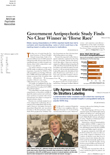A pair of new epidemiologic analyses based on large Canadian cohorts of older adults strongly suggests that the risk of developing extrapyramidal symptoms (EPS), such as parkinsonian movement disorders and tardive dyskinesia (TD), while taking antipsychotic medications is roughly the same for the newer, second-generation medications as it is for the first-generation medications, at least for the elderly.
The two analyses were published in the same month that the first findings of the National Institute of Mental Health's Clinical Antipsychotic Trials of Intervention Effectiveness (CATIE) were announced (see story on
page 1). CATIE also found differences in the risk of EPS between the two generations of drugs that were smaller than had previously been assumed.
One of the Canadian analyses appeared in the August Journal of the American Geriatrics Society and was funded by grants from the Canadian Institute for Health Research. Principal author Phillip Lee, M.D., a clinical instructor in geriatric medicine at the University of British Columbia in Vancouver, and his colleagues studied the incidence of TD in 21,835 older adults (aged 66 and older) with dementia who were residents of Ontario and were started on an antipsychotic medication between April 1997 and March 2001.
Of that number, 9,790 patients were started on a second-generation, or“ atypical,” antipsychotic (SGA), and 12,045 patients were started on a first-generation, or “typical,” antipsychotic (FGA).
The researchers found 5.24 cases of TD or other drug-induced movement disorder per 100 person-years of FGA therapy compared with 5.19 cases per 100 person-years of SGA therapy. The two were not statistically significantly different.
The second study, on which Lee was a coauthor, was published in the September 12 Archives of Internal Medicine and was also funded by Canadian government grants.
The study cohort, which was drawn from all Ontario residents aged 66 and older between April 1, 1997, and March 31, 2001, consisted of 25,769 individuals who had dementia and had not taken an antipsychotic in the previous year. There were 32,069 control subjects—individuals with no previous exposure to an antipsychotic.
Lee and his colleagues identified 449 patients who developed drug-induced parkinsonism within one year of beginning antipsychotic medication. The patients who were prescribed an FGA were 30 percent more likely to develop parkinsonism than the patients prescribed an SGA.
Furthermore, Lee told Psychiatric News that those who were prescribed a lower-potency FGA did not differ in the risk of developing parkinsonism from the control subjects. Patients prescribed a higher-potency FGA were 50 percent more likely to develop parkinsonism than those prescribed an SGA.
In addition, Lee said, they found that those patients who were prescribed high doses of an SGA were at similar risk for developing parkinsonism as those prescribed a high-potency FGA. That finding was “perhaps a little bit surprising,” Lee said, “and contrary to what has been demonstrated in other studies.”
Lee added, “We were not able to demonstrate a benefit to the newer medications in terms of a reduction in risk of these movement disorders.”
The risk of developing a movement disorder while taking any antipsychotic medication, Lee said, appears to be related to increasing dose, longer duration of use, and advancing age. In addition, women appear to be more likely to develop drug-induced parkinsonism and TD.
An abstract of “Antipsychotic Medications and Drug-Induced Movement Disorders Other Than Parkinsonism” is posted at<www.blackwell-synergy.com/doi/abs/10.1111/j.1532-5415.2005.53418.x>, and an abstract of “Atypical Antipsychotics and Parkinsonism” is posted at<http://archinte.ama-assn.org/cgi/content/abstract/165/16/1882>.▪
Arch Intern Med 2005 165 1882
